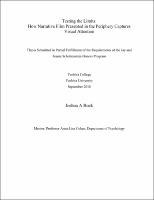Please use this identifier to cite or link to this item:
https://hdl.handle.net/20.500.12202/4354| Title: | Testing the Limits: How Narrative Film Presented in the Periphery Captures Visual Attention. |
| Other Titles: | Thesis submitted in partial fulfillment of the requirements of the Jay and Jeanie Schottenstein Honors Program, Yeshiva College, Yeshiva University, May 2018. |
| Authors: | Bock, Joshua A. |
| Keywords: | narrative film visual attention narrative engagement |
| Issue Date: | May-2018 |
| Publisher: | Yeshiva College. Yeshiva University. |
| Citation: | Testing the Limits: How Narrative Film Presented in the Periphery Captures Visual Attention. Bock, Joshua A. Thesis submitted in partial fulfillment of the requirements of the Jay and Jeanie Schottenstein Honors Program, Yeshiva College, Yeshiva University, May 2018. |
| Abstract: | Previous research (Bezdek et al., 2015; Busselle & Bilandzic, 2008; Gerrig, 1993; Hasson et al, 2008) has determined that narratives, especially when used in film, have the ability to capture the viewer’s attention and “transport” them into the story to such an extent that they may feel they have lost a sense of their current time and place. To our knowledge, no research has examined whether narratives are effective at capturing attention when they are placed outside the direct line of vision. Thirty six university students participated in this experiment. They were situated inside a room with two computer monitors that were placed side by side. One monitor was placed directly in front of them and the other monitor was positioned next to it so that it was in the participant’s near periphery, adjacent to central gaze (see figure 2). One monitor played a series of topical news segments (non-narrative) while the other played a series of short film clips (narrative). Participants were asked to focus on the monitor directly in front of them and were randomly assigned to either the narrative distractor condition, in which the peripheral monitor displayed a series of clips from various films (narrative), or the non-narrative distractor condition, in which the monitors were flipped and the peripheral monitor instead displayed a series of news clips (non-narrative) (see figure 1). Results indicated that participants were significantly more likely to shift their attention toward the film clips, and for longer durations, when the clips were positioned in their periphery and lacked an audio feed. These findings supported our hypothesis that that video content in a narrative form as opposed to a non-narrative form would be more likely to capture attention. |
| Description: | The file is restricted for YU community access only. Mentor: Professor Anna-Lisa Cohen, Department of Psychology |
| URI: | https://hdl.handle.net/20.500.12202/4354 https://ezproxy.yu.edu/login?url=https://repository.yu.edu/handle/20.500.12202/4354 |
| Appears in Collections: | Jay and Jeanie Schottenstein Honors Student Theses |
Files in This Item:
| File | Description | Size | Format | |
|---|---|---|---|---|
| Josh Bock Senior Honors Thesis 2018.pdf Restricted Access | PDF Rynhold OCR | 1.11 MB | Adobe PDF |  View/Open |
This item is licensed under a Creative Commons License

